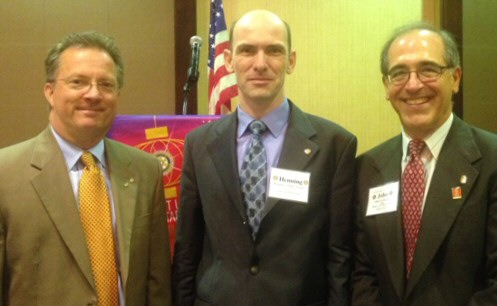JUL 22, 2014 ROTARY IN REVIEW:
Golf Pro Dave Tentis
Our weekly meeting was called to order by President John Guthmann at the DoubleTree Hotel downtown Saint Paul. David Laird led members in singing America the Beautiful. Compliments to all for the acapella performance. Bob Cardinal delivered the invocation. Roger Nielsen welcomed and introduced visiting Rotarians and guests.
Thank you to greeters Sarah Kohler and Jon Cieslak. Jay Pfaender promo'd the speakers for the next two weeks -- Ramsey County Sheriff Bostrom and Bob Senkler, Securian CEO. Members are encouraged to invite friends and colleagues. Thursday's Fellowship speaker is Jonathan Strickland of Black Rabbit Books. Well wishes for a speedy recovery were sent to Sherry Howe.
Darcie Fowler our outbound exchange student introduced herself and shared her excitement about her upcoming departure to Croatia. An outstanding Saint Paul youth and great representative of our club.
 John Andrews recognized Henning Schulze-Lauen as our newest Paul Harris Fellow and Elmer L Anderson recipient. Henning shared that Foundation donations are the very best Happy Dollar investment.
John Andrews recognized Henning Schulze-Lauen as our newest Paul Harris Fellow and Elmer L Anderson recipient. Henning shared that Foundation donations are the very best Happy Dollar investment.
Jon Cieslak hosted happy dollars. Jay Pfaender shared books donated to members from Harvey Makay. Anniversaries, births, new homes and stories of new and old friend were shared.
Jay Pfaender introduced our guest speaker, Dave Tentis
Dave discussed the current state of the golf industry with some information on upcoming local events (3M Championship & 2016 Ryder Cup).
Yearly, golf is a 70 billion business which employs nearly 2 million people and generates 55 billion in wage income. The game raises 3.9 billion for charities primarily through events hosted by 15,000 courses. Golf is a great source of exercise with 2,000 calories being burned while walking 18 holes or 1,300 when using a golf cart. Nine out of 10 golfers play at public golf courses with 76% - 90% of all rounds logged at public courses at an average cost of $26 - $28 per round.
WHY IS THE INDUSTRY STRUGGLING?
* Industry constructed 4,500+ courses in a 15 year period from the late 80’s through the 90’s to satisfy home builders looking for golf course lots and a report by NGF that baby boomers (1946-1964) would demand golf in retirement. This imbalance has resulted in aggressive discounting to attract a shrinking customer base for more courses.
*Over 5 million golfers have left the game since 2008. Last year saw 462 million total rounds played, fewest since 1995.
*Cost, time and difficulty of the game.
*Economic challenge-2008 recessions impact on discretionary spending.
*Demographic challenge- today’s Millennial Generation (1980 - 2000) saw 200,000 leave the game in 2013. They have many more options (internet, video games, etc.) which deliver instant gratification while golf is a game that requires patience.
SOLUTIONS
* Tee it forward for better pace of play and more enjoyment. Average golfer plays much too long a course.
* PGA of America’s Get Golf Ready where adult golfers can sign-up to take 5 lessons by a PGA professional for $99. In 2013 this program saw 86,000 participants which was a 13% growth over 2012. And, PGA Junior League which is golf’s version of Little League Baseball. For boys and girls age 7-13 with a 9-hole scramble format. In 2013, 8,900 kids participated.
* First Tee was created in 1997 and has had over 9 million participants. Their mission: To impact the lives of young people by providing educational programs that build character, instill life-enhancing values and promote healthy choices through the game of golf. The school program saw 6000 Elementary schools participate during the 2012-2013 school year.
* Large cups and foot golf.
President John thanked Dave and presented a gift of appreciation. Meeting was adjourned at 1:10 pm.
Trixie Golberg
Scribe

